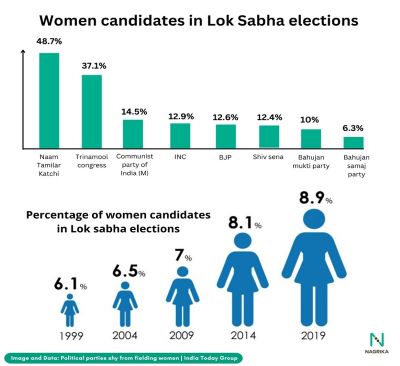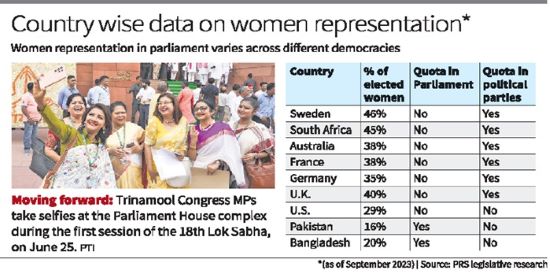Context:
In the recently concluded general elections in the U.K., a record 263 women MPs (40%) have been elected to the House of Commons. Whereas, the 2024 Lok Sabha elections in India have highlighted a complex narrative regarding women's representation in Indian politics. Despite an increase in the number of women candidates, the total number of women elected to the lower house experienced a slight decrease.
Women Representatives in Independent India
Right To Vote for Women
India, as a sovereign republic, provided the right to vote for all its women right from the first general elections in 1952. While the Right To Vote has been available since the commencement of the Constitution, the representation of women in the Lok Sabha and State legislative assemblies has been far from satisfactory.
Women Representation in Political Bodies
The percentage of women MPs in the Lok Sabha remained very low, between 5% and 10%, until 2004. It rose marginally to 12% in 2014 and currently stands at 14% in the 18th Lok Sabha. The representation in State Legislative Assemblies is even poorer, with the national average being around 9%. The 73rd and 74th amendments of the Constitution in 1992/1993 provided for one-third reservation for women in panchayats and municipalities. However, attempts between 1996 and 2008 to provide similar reservation in the Lok Sabha and assemblies were unsuccessful.
Women MPs Worldwide
Methods for Women Representation Worldwide
Women representation in parliament varies across different democracies. It is a perennial issue to promote higher representation for women who constitute half the population in all countries. The important methods used across the world to ensure higher representation of women are:
1. Voluntary or legislated compulsory quotas for candidates within political parties.
2. Quota in parliament through reservation of seats.
Quotas within political parties provide more democratic choice to voters and allow flexibility to parties in choosing women candidates. Opponents of having a reserved quota in parliament for women argue that it would be seen as women not competing on merit. As the seats reserved for women would be rotated after each delimitation, it may also reduce the incentive for MPs to work hard to nurture their constituencies. Countries like Bangladesh and Pakistan that have quotas in parliament fare poorer than countries with political party quotas.
Women Representation in Politics Worldwide
The South African National Assembly has around 45% women representation, while the U.S. House of Representatives has 29%. Women hold 36 per cent of parliamentary seats in Latin America and the Caribbean and make up 33 percent of parliamentarians in Europe and Northern America. In Eastern and South-Eastern Asia with 23 per cent, Oceania with 20 percent, Central and Southern Asia and Northern Africa and Western Asia where, in both regions, women make up 18 percent of women Members of Parliament.
Universal suffrage was achieved in various parts of the world after prolonged political movements. New Zealand, as a self-governing unit under British rule, was the first to grant universal women's suffrage in 1893. The U.K. itself provided all its women the right to vote only in 1928, and the U.S. granted equal voting rights through the nineteenth amendment only in 1920.

The 106th Amendment Act: Nari Shakti Vandan Adhiniyam
As of April 2024, India ranks 143 in the list of countries in the ‘Monthly ranking of women in national parliaments’ published by the Inter-Parliamentary Union, a global organisation for national parliaments. The Trinamool Congress has the highest proportion of women MPs in the current Lok Sabha at 38%. The ruling Bharatiya Janata Party and principal Opposition Congress party have around 13% each. Naam Tamilar Katchi, a State party in Tamil Nadu, has been following a voluntary quota of 50% for women candidates in the last three general elections.
However, voluntary or legislated quotas within political parties are unlikely to yield the desired representation in India. This is why the Parliament, through the 106th constitutional amendment in September 2023, provided for one-third reservation of seats for women in the Lok Sabha and State legislative assemblies ensuring a fair representation of women in legislatures, increasing gender sensitivity in parliamentary processes and legislation. It would also hopefully increase the number of women Ministers in the Centre and States. This reservation shall come into effect based on the delimitation exercise after the relevant figures of the first Census conducted after the commencement of this act are published. Hence, the Census, which is overdue since 2021, should be conducted without any further delay to ensure that this reservation is implemented starting with the general elections in 2029.
Expanding Participation
● Balanced Political Participation
Achieving balanced political participation between women and men in decision-making is a key goal of the Beijing Declaration and Platform for Action. Political parties should ensure adequate representation of women by actively recruiting them as candidates and prioritising them in winnable seats. Supporting local women leaders through mentorship and other initiatives can also increase women's representation in politics.
● Impact of Gender Quotas
While most countries have not yet reached gender parity, gender quotas have significantly contributed to progress. In nations with legislated candidate quotas, women’s representation in parliaments and local governments is five and seven percentage points higher, respectively, compared to those without such legislation.
● Evidence of Women's Leadership
There is increasing evidence that women's leadership enhances political decision-making processes. For instance, research on panchayats (local councils) in India found that areas with women-led councils had 62 percent more drinking water projects than those with male-led councils. In Norway, a direct causal relationship was observed between the presence of women in municipal councils and improved childcare coverage.
● Championing Gender Equality
Women leaders champion gender equality issues such as eliminating gender-based violence, advocating for parental leave and childcare, addressing pensions, promoting gender-equality laws, and pursuing electoral reform.
● Education and Training
Conducting education and training programs can empower women to participate in politics. These programs can help women build confidence, develop necessary skills, and understand the complexities of the political landscape.
● Increasing Visibility and Recognition
Women in politics should receive greater visibility and recognition for their accomplishments. This can inspire other women to get involved in politics and foster a culture of greater gender equality in the political sphere.
Conclusion
India has provided the right to vote for all its women since the first general elections in 1952. However, representation in the Lok Sabha and State legislative assemblies remains low. While other democracies have used quotas to increase women representation, India ranks 143 in women representation in national parliaments. The 106th constitutional amendment, providing one-third reservation of seats for women in the Lok Sabha and State legislative assemblies, is a significant step towards ensuring fair representation and increasing gender sensitivity in parliamentary processes. The timely conduct of the overdue Census is crucial to implementing this reservation by the general elections in 2029.
|
Probable Questions for UPSC Mains 1. Examine the significance of the 106th constitutional amendment in promoting women's political representation in India. How does this amendment aim to address the historical underrepresentation of women in Indian legislatures? (10 Marks, 150 Words) 2. Discuss the impact of gender quotas on women's representation in politics globally. What lessons can India learn from other countries that have implemented such quotas, and how can these insights be applied to improve the political participation of women in India? (12 Marks, 250 Words) |
Source: The Hindu







